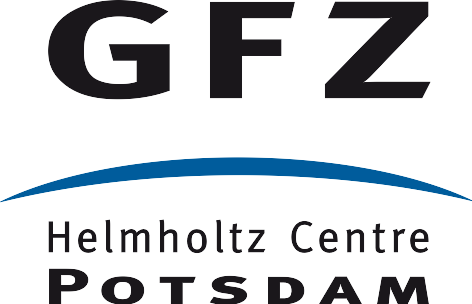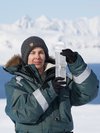DEEP PURPLE
European Research Council (ERC) Synergy Grant “DEEP PURPLE: Darkening of the Greenland Ice Sheet”
The stability of the Greenland Ice Sheet (GrIS) is a threat to coastal communities worldwide. The PIs have changed our understanding of why it darkens during the melt season, becoming increasingly deep purple due to pigmented ice algal blooms in the ice surface, producing more melt and accelerating the GrIS towards its tipping point, and increasing sea level.
The next step jump in our understanding of biological darkening will be provided by DEEP PURPLE, which will establish the factors that control ice algal blooms. These factors are essential for modelling of future melting, which require a process-based understanding of blooming. DEEP PURPLE will quantify the synergies between the biology, chemistry and physics of ice algae micro-niches in rotting, melting ice, and examine the combination of factors which stabilize them.
State-of-the-science analytical and observational methods will be employed to characterize the complex mosaic of wet ice habitats, dependent on factors such as the hydrology, nutrient status, particulate content and light fields within these continually evolving ice-water-particulate-microbe systems. We will quantitatively assess why and how the fine light mineral dust particulates contained within the melting ice amplify the growth of ice algae.
The particulate content and composition of different layers in the GrIS is dependent on age, and so the algae that the melting ice can support may fundamentally change over time. We look back to understand if the ice biome has changed through the Anthropocene via analyze of fjord sediments. The first draft genome of ice algae will show their key adaptations to glacier surface habitats. DEEP PURPLE looks forward by providing the critical field data sets and conceptual models of ice algal growth that will facilitate the next generation of predictive models of sea level rise due to biologically enhanced melting of the GrIS.
For more detailed information on the project, please see the official DEEP PURPLE website.
Research Updates
PhD students of the Interface Geochemistry research group will provide semi-annual updates detailing their research to date. These can be accessed by clicking on the link below.
- Geochemistry and Carbon Dynamics of Arctic Ecosystems, 2022
- Microbial ‘Omics’ Focusing on Biodiversity and Physiology of Bacteria and Micro-eukaryotes, 2022
- Geochemistry and Carbon Dynamics of Arctic Ecosystems, 2021
- Microbial ‘Omics’ Focusing on Biodiversity and Physiology of Bacteria and Micro-eukaryotes, 2021
Recent Publications
(authors from the group in bold)
Feng, S., Wehrlé, A., Cook, J. M., Anesio, A. M., Box, J. E., Benning, L. G., & Tranter, M. (2024). The apparent effect of orbital drift on time series of MODIS MOD10A1 albedo on the Greenland ice sheet. Science of Remote Sensing, 9, 100116. https://doi.org/10.1016/j.srs.2023.100116
Doting, E. L., Jensen, M. B., Peter, E. K., Ellegaard‐Jensen, L., Tranter, M., Benning, L. G., Hansen, M., Anesio, A. M. (2024): The exometabolome of microbial communities inhabiting bare ice surfaces on the southernGreenland Ice Sheet. - Environmental Microbiology, 26, 2, e16574. https://doi.org/10.1111/1462-2920.16574
Feng, S., Cook, J. M., Naegeli, K., Anesio, A. M., Benning, L. G., & Tranter, M. (2024). The impact of bare ice duration and geo-topographical factors on the darkening of the Greenland Ice Sheet. Geophysical Research Letters, 51, e2023GL104894. https://doi. org/10.1029/2023GL104894
Feng, S., Cook, J. M., Onuma, Y., Naegeli, K., Tan, W., Anesio, A. M., Benning, L. G., Tranter, M. (2023): Remote sensing of ice albedo using harmonized Landsat and Sentinel 2 datasets: validation. - International Journal of Remote Sensing. https://doi.org/10.1080/01431161.2023.2291000
Jaarsma, A. H., Zervas, A., Sipes, K., Campuzano Jiménez, F., Smith, A. C., Svendsen, L. V., Thøgersen, M. S., Stougaard, P., Benning, L. G., Tranter, M., Anesio, A. M. (2023): The undiscovered biosynthetic potential of the Greenland Ice Sheet microbiome. - Frontiers in Microbiology, 14, 1285791. https://doi.org/10.3389/fmicb.2023.1285791
Ciftci, O., Wagemaker, C. A. M., Mertens, A., van Bodegom, P., Pirovano, W., Gravendeel, B. (2023): Genotyping by sequencing for estimating relative abundances of diatom taxa in mock communities. - BMC Ecology and Evolution, 23, 4. https://doi.org/10.1186/s12862-023-02104-2
Jaarsma, A. H., Sipes, K., Zervas, A., Campuzano Jiménez, F., Ellegaard-Jensen, L., Thøgersen, M. S., Stougaard, P., Benning, L. G., Tranter, M., Anesio, A. M. (2023): Exploring microbial diversity in Greenland Ice Sheet supraglacial habitats through culturing-dependent and -independent approaches. - FEMS Microbiology Ecology, 99, 11, fiad119. https://doi.org/10.1093/femsec/fiad119
Halbach, L., Chevrollier, L.-A., Cook, J. M., Stevens, I. T., Hansen, M., Anesio, A. M., Benning, L. G., Tranter, M. (2023): Dark ice in a warming world: advances and challenges in the study of Greenland Ice Sheet's biological darkening. - Annals of Glaciology, 63, 87-89, 95-100. https://doi.org/10.1017/aog.2023.17
Chevrollier, L.-A., Cook, J. M., Halbach, L., Jakobsen, H., Benning, L. G., Anesio, A. M., Tranter, M. (2023): Light absorption and albedo reduction by pigmented microalgae on snow and ice. - Journal of Glaciology, 69, 274, 333-341. https://doi.org/10.1017/jog.2022.64
Feng, S., Cook, J. M., Onuma, Y., Naegeli, K., Tan, W., Anesio, A. M., Benning, L. G., Tranter, M. (2023): Remote sensing of ice albedo using harmonized Landsat and Sentinel 2 datasets: validation. - International Journal of Remote Sensing. https://doi.org/10.1080/01431161.2023.2291000
Bradley, J., Trivedi, C. B., Winkel, M., Mourot, R., Lutz, S., Larose, C., Keuschnig, C., Doting, E., Halbach, L., Zervas, A., Anesio, A. M., Benning, L. G. (2023): Active and dormant microorganisms on glacier surfaces. - Geobiology, 21, 2, 244-261. https://doi.org/10.1111/gbi.12535
Halbach, L., Chevrollier, L.-A., Doting, E. L., Cook, J. M., Jensen, M. B., Benning, L. G., Bradley, J., Hansen, M., Lund-Hansen, L. C., Markager, S., Sorrell, B. K., Tranter, M., Trivedi, C. B., Winkel, M., Anesio, A. M. (2022): Pigment signatures of algal communities and their implications for glacier surface darkening. - Scientific Reports, 12, 17643. https://doi.org/10.1038/s41598-022-22271-4
Doting, E. L., Davie-Martin, C. L., Johansen, A., Benning, L. G., Tranter, M., Rinnan, R., Anesio, A. M. (2022): Greenland Ice Sheet Surfaces Colonized by Microbial Communities Emit Volatile Organic Compounds. - Frontiers in Microbiology, 13, 886293. https://doi.org/10.3389/fmicb.2022.886293
Trivedi, C. B., Keuschnig, C., Larose, C., Rissi, D., Mourot, R., Bradley, J., Winkel, M., Benning, L. G. (2022): DNA/RNA Preservation in Glacial Snow and Ice Samples. - Frontiers in Microbiology, 13, 894893. https://doi.org/10.3389/fmicb.2022.894893
Winkel, M., Trivedi, C. B., Mourot, R., Bradley, J., Vieth-Hillebrand, A., Benning, L. G. (2022): Seasonality of Glacial Snow and Ice Microbial Communities. - Frontiers in Microbiology, 13, 876848. https://doi.org/10.3389/fmicb.2022.876848
Sert, M. F., Niemann, H., Reeves, E. P., Granskog, M. A., Hand, K. P., Kekäläinen, T., Jänis, J., Rossel, P. E., Ferré, B., Silyakova, A., Gründger, F. (2022): Compositions of dissolved organic matter in the ice-covered waters above the Aurora hydrothermal vent system, Gakkel Ridge, Arctic Ocean. - Biogeosciences, 19, 2101-2120. https://doi.org/10.5194/bg-19-2101-2022
Lau, G. E., Trivedi, C. B., Grasby, S. E., Spear, J. R., Cosmidis, J., Templeton, A. S. (2022): Sulfur- and Iron-Rich Mineralogical Features Preserved in Permafrost in the Canadian High Arctic: Analogs for the Astrobiological Exploration of Mars. - Frontiers in Astronomy and Space Sciences, 9, 825019. https://doi.org/10.3389/fspas.2022.825019
Hotaling, S., Lutz, S., Dial, R. J., Anesio, A. M., Benning, L. G., Fountain, A. G., Kelley, J. L., McCutcheon, J., Skiles, S. M., Takeuchi, N., Hamilton, T. L. (2021): Biological albedo reduction on ice sheets, glaciers, and snowfields. - Earth-Science Reviews, 220, 103728. https://doi.org/10.1016/j.earscirev.2021.103728
McCutcheon, J., Lutz, S., Williamson, C., Cook, J. M., Tedstone, A. J., Vanderstraeten, A., Wilson, S. A., Stockdale, A., Bonneville, S., Anesio, A. M., Yallop, M. L., McQuaid, J. B., Tranter, M., Benning, L. G. (2021). Mineral phosphorus drives glacier algal blooms on the Greenland Ice Sheet. Nature Communications, 12, 570. DOI: 10.1038/s41467-020-20627-w.










